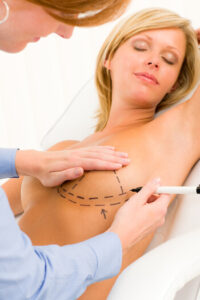The Australian Breast Device Registry (ABDR) has reported that an estimated 20,000 women each year in Australia opt for breast augmentation surgery – either to enhance their appearance or reconstruct the area after a cancer diagnosis.
Breast augmentation surgery is a significant medical procedure, so you should make sure it’s the right decision for you before making any commitments. Ensure that your research has been thorough prior to undergoing surgery, as this will give you an insight into what to expect post-operation and during recovery.
Are you curious about breast augmentation? Before getting your hopes up and imagining yourself with an improved body, read this blog post in order to gain a comprehensive understanding of what the surgery entails. We will cover all aspects from the procedure to recovery so that you can make an informed decision when it’s time for the procedure.
What is breast augmentation surgery?
If you feel that your breasts are not balanced in size or shape, breast augmentation surgery offers a way to enhance your body and self-confidence. It can increase the fullness of both breasts as well as reduce any asymmetry, restore post-pregnancy volume loss, and reshape them for aesthetic purposes. It is also an invaluable procedure if one side is impacted by mastectomy or trauma. Breast augmentation improves more than just appearance; it positively impacts body image too.
Achieving confidence is the ultimate mission of breast augmentation surgery. If your insecurities about your breasts have been impeding your life, then this procedure may be the key to restoring that sense of assurance and positive body image you desire. Breast augmentation has helped many women look and feel better within themselves – why shouldn’t it do the same for you?
Procedure
As you now understand the concept of breast augmentation, let’s delve further into details about what will happen during the procedure. Breast augmentation is a substantial surgical process; therefore, it’s paramount that you are fully aware of its demands before your operation. Make sure to have an in-depth conversation with your surgeon so that on the day of surgery, you can feel relaxed and assured going into the operating room.
When it comes to breast surgery, you have the option of inserting implants either underneath your chest muscles or behind your breast tissue. These small sacks are filled with a silicone or saline material and give an instantly noticeable boost in size and shape.


It’s important to note, though, that if any leaks were to arise from a silicone implant, it could result in further complications.
Luckily for you, both types of implants are available in several sizes.
When selecting an implant with your surgeon, it is essential to factor in personal preferences such as size, shape and feel. You have the option of saline or silicone implants which can be smooth or textured, round or tear-drop shaped.
To ensure that you are content with your results, take time to consider all options before making a decision – don’t hesitate to reach out for guidance from your surgeon if needed.
When it comes to the actual procedure, you have two options – general or local anesthesia. General anesthesia is more typical since it makes the process completely painless, as you will be asleep during your surgery. On the other hand, local anaesthesia numbs your breasts so that there’s no sensation of pain while being awake throughout the entire operation.
When it comes to inserting breast implants, there are four main procedures available for a surgeon to choose from. These include placing the implant under the breast, through the armpit, around the nipple or via an incision in and around your belly button. Learn more about each of these techniques below:
Under the breast
When undergoing the procedure, an experienced doctor will create a precise incision in the fold under each breast. The implant is then carefully inserted through this opening without any harm or loss of milk ducts for those who plan to nurse at some point in time. With skilful execution from a knowledgeable provider, most patients report that their scarring can be easily hidden when wearing bras and bikinis.
The potential drawback of this approach is that the scar might stretch following the surgery. It’s not an ideal solution for women with extremely small breasts as it becomes more complicated for surgeons to conceal the incision in the crease under the breast.
Through the armpit
An alternative placement method for breast implants involves a cut beneath the armpit. Using an endoscope, which comprises both a camera and surgical instrumentation, your surgeon will insert your implants via this incision.
The positive aspect of this method is that it leaves your breasts untouched and hence, no visible scarring. For women wanting to breastfeed in the future, no interference with nipples occurs. However, there are some drawbacks, such as difficulty for a surgeon in positioning implants correctly, plus an obvious mark below the armpit will remain post-surgery.
Around the nipple
With the periareolar approach, the surgeon will make an exact cut around your areola and introduce the implant through that opening. This method results in less obvious scarring than other options while also allowing for further adjustments if needed. However, it can lead to loss of sensation near your nipple area as well as potential issues with breastfeeding in the future.
For those desiring the ability to breastfeed, this approach works well as it does not damage the breasts. In addition, scarring is minimal since an incision around your belly button serves as access for a tunnel that leads up to the breasts. Saline implants are suitable for insertion through this method, though there exists more of a risk of implant distortion due to its distance from where surgeon control would be optimal.


No matter the insertion technique that you choose, scars will result from breast augmentation surgery. However, there are benefits and drawbacks to each option; it is wise to discuss these in detail with your surgeon prior to making a decision so you can pick what works best for you. The location of the scarring and its appearance depends on which type of implantation method was utilised by your surgeon.
Recovery
Recovery is unique to each individual. Your recovery length and intensity may be impacted by the implant type, size, or insertion technique you’ve chosen. Following surgery, your breasts will most likely experience soreness and swelling for a few weeks. To ensure that your implants are placed correctly during this period of healing, it’s recommended to wear either a compression bandage or sports bra for extra support and positioning.
Being mindful and patient during the healing process is vital. Despite feeling okay, it could take a while before you can return to your usual activities. After surgery, abstain from strenuous activity for two weeks at least – this optimises post-op recovery of your breasts. Pay extra attention if there’s any sign of warmth in them or fever ensues; be sure to reach out to your surgeon if you notice anything unusual.
Ultimately, it’s best to plan for at least a couple of weeks away from work following surgery so you can adequately heal. Make sure to communicate with your employer about taking leave or working remotely in order to give yourself the time needed for recovery. After all, it’s essential that you prioritise your health and well-being as much as possible during the recovery period. After your breast augmentation procedure, your enthusiasm for seeing the results may be overwhelming. However, it’s important to remember that recovery takes time and will not happen overnight – you should plan on waiting up to three months before you can see the final result of your surgery. Your breasts may seem super augmented than expected right after the surgery due to swelling; however, don’t worry, as they will naturally drop down over time, looking more natural in appearance.
Risks
Before you decide to get breast augmentation surgery, it is important to be familiar with the potential dangers associated with it. Pain in breasts, infection, loss of sensation in nipples and implant leakage or rupture are all possible risks that can occur during this procedure. Improper positioning of the implants or anesthesia-related issues may arise, as well as poor scarring and a negative impact on lactation capabilities. Make sure you think carefully about these risks before taking any steps towards getting breast augmentation surgery done.
Before deciding to undergo any surgical procedure, it is critical that you speak with your surgeon and discuss all possible risks, side effects, and questions.
What is the difference between breast augmentation and breast implant surgery?
Have you ever been confused about the distinction between breast augmentation and implants? In reality, there is no difference! People use these phrases interchangeably. Breast augmentation is simply referring to the surgical procedure that enlarges breasts’ size or modifies their shape, whereas breast implants are just what doctors insert (with either saline or silicone) during said surgery.
In contrast, a breast lift is an operation only meant to make the breasts firmer and perkier. It does not involve any implants or changes in size; instead, it just lifts the tissue itself. This type of surgery is ideal for women who are looking to restore their youthful appearance without changing cup sizes, specifically those dealing with age-related sagging or post-pregnancy saggy boob syndrome (PPS). With a breast lift, you can look young again.
Although a breast lift is less invasive than getting a breast augmentation, if you want to increase the size of your breast, enlargement is the only way to achieve that goal. Many women choose to get both procedures done at once so they can have their ideal final look. Even though it’s less invasive, you will still be left with scars from the lift. You’ll need two weeks minimum to recover from either surgery and will have scarring from both procedures.
To gain insight into which type of breast augmentation is most suitable for you, it is essential to visit Refine Clinic and speak with a team of experienced surgeons. They will provide all available options – including saline implants, cohesive gel, silicone or fat transfer – allowing you to make the best decision on your journey towards achieving a natural-looking bustline.
Book an appointment with us today for a consultation to find out how breast augmentation can give you subtle, natural results that will make a powerful impact.
Note: Any surgical or invasive procedure carries risks. Before proceeding, you should seek a second opinion from an appropriately qualified health practitioner.
References
Breast Augmentation
https://www.healthline.com/health/breast-augmentation
Breast implants
https://www.webmd.com/beauty/cosmetic-procedures-breast-augmentation





